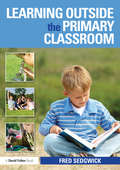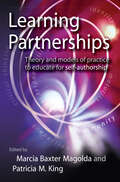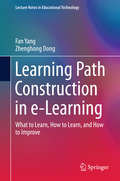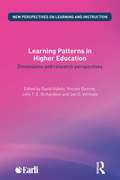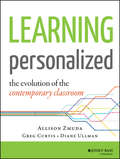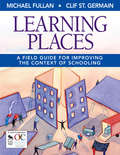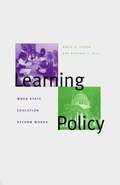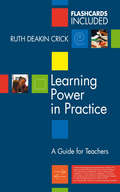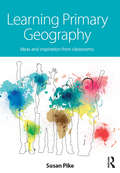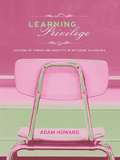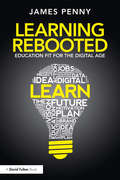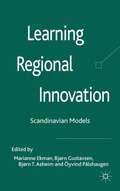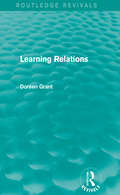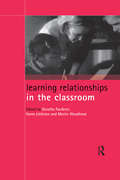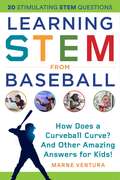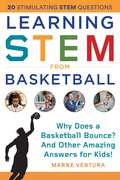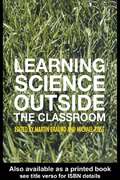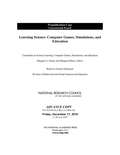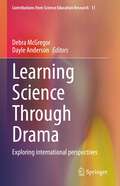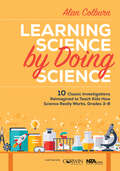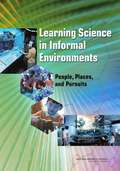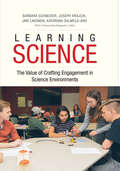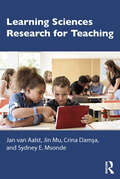- Table View
- List View
Learning Outside the Primary Classroom
by Fred Sedgwick"We believe that every young person should experience the world beyond the classroom as an essential part of learning and personal development, whatever their age, ability or circumstances. Learning outside the classroom is about raising achievement through an organised, powerful approach to learning in which direct experience is of prime importance." LOTC Initiative manifesto In Learning Outside the Primary Classroom, the educationalist and writer Fred Sedgwick explores in a practical way the many opportunities for intense learning that children and teachers can find outside the confines of the usual learning environment, the classroom. This original work is based on tried and tested methods from UK primary schools. The author draws on current concerns in the educational world regarding outdoor learning as exemplified by the eight sector Learning Outside the Classroom (LOtC) initiative (supported by Ofsted), but remains refreshingly independent in approach. Using a metaphor of concentric circles Learning Outside the Primary Classroom starts with a brief opening chapter based in the classroom itself before moving outwards to explore the learning possibilities presented by the immediate environs of the school – playgrounds, gym halls, sports fields etc. Later chapters move beyond the school gates to explore the local shops, parks, religious centres, libraries and town halls and the myriad learning opportunities they represent. The final chapters explore the possibilities of larger scale day trips to major galleries and museums and more ambitious field trips.
Learning Partnerships: Theory and Models of Practice to Educate for Self-Authorship
by Patricia M. King Marcia B. Baxter MagoldaWhile a common goal of higher education is to improve student learning to prepare young adults for the professional, civic and personal challenges of their lives, few institutions have a model to facilitate these outcomes. Learning Partnerships offers a grounded theory and practical examples of how these objectives can be achieved at the college course, program, and institutional levels.The book takes as its foundation Marcia Baxter Magolda’s "Learning Partnerships Model" based on her seventeen-year longitudinal study of young adults’ learning and development from their undergraduate years through their thirties. Based on nearly a thousand participant narratives, the model offers an empirically grounded yet flexible approach to promote "self-authorship." Marcia Baxter Magolda describes the nature of self-authorship--its centrality to the learning goals of cognitive maturity, an integrated identity, mature relationships, and effective citizenship--and the Model.The book then documents examples of actual practice and the learning outcomes they have yielded. The settings include community college and undergraduate courses, exchange and internship programs, residential life, a Masters’ program, faculty development and student affairs organization.Learning Partnerships offers models for all educators--faculty and student affairs staff alike--who work to balance guidance and learner responsibility to prepare students for the complexity of the twenty-first century.
Learning Path Construction in e-Learning
by Fan Yang Zhenghong DongThis book focuses on developing methods for constructing learning paths in terms of "learning resources" (learning contents), "learning approaches" (learning method), and "learning quality" (learning performance) to support learning. This book defines different teaching approaches for learning activities and organizes them into a learning path which indicates the learning sequence. This book introduces how to automatically generate well-structured learning resources for different students. Also, this book introduces a method about how to generate adaptive learning approach to learn learning resources for different students. Finally, this book introduces a method to monitor and control learning quality. The adaptive learning path expresses well-structured learning contents, using which approach to access those learning contents, and in which sequence to carry out the learning process. The learning path comes with a monitoring tool to control the learning progress, which helps to make students having a balanced development on different knowledge and abilities. Researchers who worked in E-learning area, both education and computer sciences people. Educators who worked in educational institutes, such as Universities, Schools, etc. They would like to use or study E-learning tools/technologies/methods in their own work. And technicians who run/design educational websites will understand the appeal of this work.
Learning Patterns in Higher Education: Dimensions and research perspectives (New Perspectives on Learning and Instruction)
by John T. E. Richardson David Gijbels Jan D. Vermunt Donche VincentLearning Patterns in Higher Education brings together a cutting edge international team of contributors to critically review our current understanding of how students and adults learn, how differences and changes in the way students learn can be measured in a valid and reliable way, and how the quality of student learning may be enhanced. There is substantial evidence that students in higher education have a characteristic way of learning, sometimes called their learning orientation (Biggs 1988), learning style (Evans et al. 2010) or learning pattern (Vermunt and Vermetten 2004). However, recent research in the field of student learning has resulted in multi-faceted and sometimes contradictory results which may reflect conceptual differences and differences in measurement of student learning in each of the studies. This book deals with the need for further clarification of how students learn in higher education in the 21st century and to what extent the measurements often used in learning pattern studies are still up to date or can be advanced with present methodological and statistical insights to capture the most important differences and changes in student learning. The contributions in the book are organized in two parts: a first conceptual and psychological part in which the dimensions of student learning in the 21st century are discussed and a second empirical part in which questions related to how students’ learning can be measured and how it develops are considered. Areas covered include: Cultural influences on learning patterns Predicting learning outcomes Student centred learning environments and self-directed learning Mathematics learning This indispensable book covers multiple conceptual perspectives on how learning patterns can be described and effects and developments can be measured, and will not only be helpful for ‘learning researchers’ as such but also for educational researchers from the broad domain of educational psychology, motivation psychology and instructional sciences, who are interested in student motivation, self-regulated learning, effectiveness of innovative learning environments, as well as assessment and evaluation of student characteristics and learning process variables.
Learning Personalized
by Greg Curtis Diane Ullman Allison ZmudaA real-world action plan for educators to create personalized learning experiences Learning Personalized: The Evolution of the Contemporary Classroom provides teachers, administrators, and educational leaders with a clear and practical guide to personalized learning. Written by respected teachers and leading educational consultants Allison Zmuda, Greg Curtis, and Diane Ullman, this comprehensive resource explores what personalized learning looks like, how it changes the roles and responsibilities of every stakeholder, and why it inspires innovation. The authors explain that, in order to create highly effective personalized learning experiences, a new instructional design is required that is based loosely on the traditional model of apprenticeship: learning by doing. Learning Personalized challenges educators to rethink the fundamental principles of schooling that honors students' natural willingness to play, problem solve, fail, re-imagine, and share. This groundbreaking resource: Explores the elements of personalized learning and offers a framework to achieve it Provides a roadmap for enrolling relevant stakeholders to create a personalized learning vision and reimagine new roles and responsibilities Addresses needs and provides guidance specific to the job descriptions of various types of educators, administrators, and other staff This invaluable educational resource explores a simple framework for personalized learning: co-creation, feedback, sharing, and learning that is as powerful for a teacher to re-examine classroom practice as it is for a curriculum director to reexamine the structure of courses.
Learning Places: A Field Guide for Improving the Context of Schooling
by Michael Fullan Clif St. GermainThis user-friendly guide provides interactive self-assessment protocols for promoting a sense of purpose, achieving program coherence, invigorating classroom teaching, and supporting the professional development of teachers.
Learning Policy: When State Education Reform Works
by David K. Cohen Heather C. HillThis book reports on one of the more significant school-improvement policies in late-twentieth-century America: California's decade-long effort to change and improve mathematics teaching in the state's public schools.
Learning Power in Practice: A Guide for Teachers
by Ruth Deakin Crick'This book provides a variety of ideas for use in the classroom, based on practical applications of the conceptual understanding of learning power... ...[It] tells the reader about the "Effective Lifelong Learning Inventory" research programme (ELLI) and uses practical examples of how it can work in actual classes to explain its effectiveness. Its value for practitioners working with children with SEN appears to be in the way it challenges them to look at themselves as learners - also how they can support the children they work with to become more effective learners' - Special Needs Coordinator's File 'This is not a gimmicky approach... The approach here fosters deeper understanding for both the teacher and learner of exactly what the process involves... It contains much to interest schoolteachers, senior managers and those involved with learners of any age' - ESCalate Contains Learning Power flash cards! What kind of learner are you? How can you become a better learner? This book puts the findings of the well known Effective Lifelong Learning Inventory (ELLI) research programme into the practical context of the classroom, helping you to find answers to these questions. The book offers many suggestions for practical ways to improve the learning power of all the children in your class. It looks at: " learning power - what it is and how it can be achieved " creating the right classroom environment for powerful learning " how learning power works in the primary and secondary school classroom " how animal metaphors can be used with children to explain concepts. This is an exciting read for anyone interested in how children learn, and how we can help them to learn more effectively. It fits in very well with the debate around such concepts as accelerated learning, thinking skills and learning styles.
Learning Primary Geography: Ideas and inspiration from classrooms
by Susan PikeLearning Primary Geography: Ideas and inspiration from classrooms celebrates children’s learning in primary geography. It is a book for all student and practising teachers who would like children to learn about their world in an enjoyable and stimulating way. Every page presents inspiring examples of children’s learning, and explains how and why creative approaches such as enquiry learning, learning outside the classroom, and using imaginative resources work so well in primary geography. Using illustrated case studies from a range of schools and classrooms, each chapter showcases the fantastic work all children can do in primary geography. The book explores a wide variety of geographical learning, with chapters focusing on key aspects of the subject, including: primary geography through the school grounds topical geography through issues and events learning about places in primary geography children’s agency and action through primary geography Throughout the chapters, the role of primary geography in helping children develop all types of literacies, including spatial, critical and digital literacies, is explored. Written by a highly experienced teacher and lecturer in education, Learning Primary Geography is underpinned and illustrated by examples from a wide range of primary classrooms. It will be a source of support, guidance and inspiration for all those teaching geography in the primary school.
Learning Privilege: Lessons of Power and Identity in Affluent Schooling
by Adam HowardHow can teachers bridge the gap between their commitments to social justice and their day to day practice? This is the question author Adam Howard asked as he began teaching at an elite private school and the question that led him to conduct a six-year study on affluent schooling. Unfamiliar with the educational landscape of privilege and abundance, he began exploring the burning questions he had as a teacher on the lessons affluent students are taught in schooling about their place in the world, their relationships with others, and who they are. Grounded in an extensive ethnographic account, Learning Privilege examines the concept of privilege itself and the cultural and social processes in schooling that reinforce and regenerate privilege. Howard explores what educators, students and families at elite schools value most in education and how these values guide ways of knowing and doing that both create high standards for their educational programs and reinforce privilege as a collective identity. This book illustrates the ways that affluent students construct their own privilege,not, fundamentally, as what they have, but, rather, as who they are.
Learning Rebooted: Education Fit for the Digital Age
by James PennyArguing that education systems are failing to keep up with the pace of change in society, The System Rebooted: Education Fit For the Digital Age, sets out a unique proposal for system-wide radical change. Focusing on the transformations needed in order to align education systems with current trends in society, the book stimulates discussion by offering a heightened understanding of what education reform needs to look like, and suggesting a way forward for both individual schools and whole systems. The book makes a clear delineation between learning and education, building a case for how learning, an essential skill, is often not allowed to flourish in many modern education systems. Chapters explore how rapid changes to technology are shaping the way young people share, collaborate and communicate and, arguing that education systems continue to produce young people who are not equipped with the skills that society needs, the book makes a cogent case for how education systems need to reflect these profound changes, as well as highlighting how learning organisations could rationalise their expenditure on technology. This unique and radical book brings topical issues to the forefront of discussion, and is essential reading for school leaders, policy makers, and governors.
Learning Regional Innovation
by Marianne Ekman Bj�rn Gustavsen Bj�rn T. Asheim �yvind P�lshaugenParticipation and social responsibility in innovation is the core theme of this book. Both are issues of organization and not of ethics, or the enforcement of other forms of obligations on individual actors. The need is for a democratization of innovation that can make innovation open to broad participation.
Learning Relations (Routledge Revivals)
by Doreen GrantDissatisfied with the effects of schooling on children from low-income families, Doreen Grant left her post as head of a secondary school in Liverpool and turned to research for solutions to this perennial social problem. This is a popular account of her involvement with under-privileged Glaswegian parents and children, and her attempt to address the problem of underachievement from the perspective of the home rather than the educational establishment. Combining the theory of international scholars such as Brofenbrenner, Bruner, Donaldson and Freire with practical experience, Doreen Grant indicates the improvements in children’s active learning when parents participate fully in the process of education. Learning Relations, first published in 1989, describes the creation of a coherent learning environment in the inner city: as parents gain confidence in their personal vocation as natural educators, it becomes clear that they are not only willing but fully capable of improving their children’s chances of success.
Learning Relationships in the Classroom
by Martin Woodhead Karen Littleton Dorothy FaulknerThis reader explores the nature of interactions between children and their teachers in the classroom. It emphasises the importance of such relationships for children's learning and for educational practice. Part 1 looks at different cultural conceptions of the teacher-learner relationship, and how this relates to schooling, cognitive development and the aquisition of knowledge. Part 2 takes a closer look at the role of language and dialogue in interactions between adults and children in classrooms. Part 3 describes research by developmental psychologists on peer interaction and collaborative learning, and discusses how it has advanced our understanding of how children learn from each other. Part 4 considers the implications of classroom-based collaborative learning initiatives and the potential for creating 'communities of enquiry' which change how we think about knowledge acquisition.
Learning STEM from Baseball: How Does a Curveball Curve? And Other Amazing Answers for Kids! (STEM Sports)
by Marne VenturaGet your sports-loving kid excited about Science, Technology, Engineering, and Math By integrating the thrill of learning into the context of baseball, Learning STEM from Baseball presents a whole new ball game. Unleash the inner scientist, engineer, and mathematician in your child as they learn that sports and STEM aren't so separate after all. You'll both love finding out the answers to questions such as: What's a sweet spot?When was the pitching machine invented?How are baseballs made?How do numbers help baseball players? What are some STEM careers in baseball?And so much more! This easy-to-follow introduction to STEM topics sets kids up to make connections across subjects, discover new facts about baseball, and grow curious about academic fields!
Learning STEM from Basketball: Why Does a Basketball Bounce? And Other Amazing Answers for Kids! (STEM Sports)
by Marne VenturaGet your sports-loving kid excited about Science, Technology, Engineering, and Math By integrating the thrill of learning into the context of basketball, Learning STEM from Basketball presents an educational slam dunk. Unleash the inner scientist, engineer, and mathematician in your child as they learn that sports and STEM aren't so separate after all. You'll both love finding out the answers to questions such as: Why does a basketball bounce?What's a shot clock?Why does a basketball rim have a net?What's the math behind a free throw?And so much more! This easy-to-follow introduction to STEM topics sets kids up to make connections across subjects, discover new facts about basketball, and grow curious about academic fields!
Learning Science Outside the Classroom
by Martin Braund and Michael ReissThis book shows how a wide range of contexts for learning science can be used outside of the classroom, and includes learning: at museums, science centres and planetaria from newspapers, magazines and through ICT at industrial sites and through science trails at zoos, farms, botanic gardens, residential centres and freshwater habitats in school grounds. With contributions from well known and respected practitioners in all fields of science education and through using case studies, Learning Science Outside the Classroom offers practical guidance for teachers, assistant teaching staff and student teachers involved in primary and secondary education. It will help enable them to widen the scientific experience and understanding of pupils. The advice in this book has been checked for safety by CLEAPSS.
Learning Science Through Computer Games and Simulations
by National Research Council of the National AcademiesAt a time when scientific and technological competence is vital to the nation's future, the weak performance of U.S. students in science reflects the uneven quality of current science education. Although young children come to school with innate curiosity and intuitive ideas about the world around them, science classes rarely tap this potential. Many experts have called for a new approach to science education, based on recent and ongoing research on teaching and learning. In this approach, simulations and games could play a significant role by addressing many goals and mechanisms for learning science: the motivation to learn science, conceptual understanding, science process skills, understanding of the nature of science, scientific discourse and argumentation, and identification with science and science learning. To explore this potential, Learning Science: Computer Games, Simulations, and Education, reviews the available research on learning science through interaction with digital simulations and games. It considers the potential of digital games and simulations to contribute to learning science in schools, in informal out-of-school settings, and everyday life. The book also identifies the areas in which more research and research-based development is needed to fully capitalize on this potential. Learning Science will guide academic researchers; developers, publishers, and entrepreneurs from the digital simulation and gaming community; and education practitioners and policy makers toward the formation of research and development partnerships that will facilitate rich intellectual collaboration. Industry, government agencies and foundations will play a significant role through start-up and ongoing support to ensure that digital games and simulations will not only excite and entertain, but also motivate and educate.
Learning Science Through Drama: Exploring international perspectives (Contributions from Science Education Research #11)
by Dayle Anderson Debra McGregorThis book presents a wide range of international perspectives that explore the different ways the diverse forms of drama supports learning in science. It illustrates how learning science by adopting and adapting theatrical techniques can offer more inclusive ways for students to relate to scientific ideas and concepts. The theatrical processes by which subject matter can be introduced, thought about, discussed, transformed, enacted and disseminated are shown to be endless. The first section of the book considers different ways of theorising and applying drama in classrooms. The second section provides a range of case studies illustrating how role play, performance, embodiment and enquiry approaches can be utilised for learning in primary, secondary and tertiary education contexts. The third section demonstrates how different research methods from questionnaires, particular kinds of tests and even the theatrical conventions themselves can provide rich data that informs how drama impacts on learning science.
Learning Science by Doing Science: 10 Classic Investigations Reimagined to Teach Kids How Science Really Works, Grades 3-8
by Alan ColburnTime-tested activities to teach the key ideas of science—and turn students into scientists! This witty book adapts classic investigations to help students in grades 3 through 8 truly think and act like scientists. Chapter by chapter, this accessible primer illustrates a “big idea” about the nature of science and offers clear links to the Next Generation Science Standards and its Science and Engineering Practices. You’ll also find: A reader-friendly overview of the NGSS Guidance on adapting the activities to your grade level, including communicating instructions, facilitating discussions, and managing safety concerns Case studies of working scientists to highlight specifics about the science and engineering practices
Learning Science by Doing Science: 10 Classic Investigations Reimagined to Teach Kids How Science Really Works, Grades 3-8
by Alan ColburnTime-tested activities to teach the key ideas of science—and turn students into scientists! This witty book adapts classic investigations to help students in grades 3 through 8 truly think and act like scientists. Chapter by chapter, this accessible primer illustrates a “big idea” about the nature of science and offers clear links to the Next Generation Science Standards and its Science and Engineering Practices. You’ll also find: A reader-friendly overview of the NGSS Guidance on adapting the activities to your grade level, including communicating instructions, facilitating discussions, and managing safety concerns Case studies of working scientists to highlight specifics about the science and engineering practices
Learning Science in Informal Environments: People, Places, and Pursuits
by National Research Council of the National AcademiesInformal science is a burgeoning field that operates across a broad range of venues and envisages learning outcomes for individuals, schools, families, and society. The evidence base that describes informal science, its promise, and effects is informed by a range of disciplines and perspectives, including field-based research, visitor studies, and psychological and anthropological studies of learning. Learning Science in Informal Environments draws together disparate literatures, synthesizes the state of knowledge, and articulates a common framework for the next generation of research on learning science in informal environments across a life span. Contributors include recognized experts in a range of disciplines--research and evaluation, exhibit designers, program developers, and educators. They also have experience in a range of settings--museums, after-school programs, science and technology centers, media enterprises, aquariums, zoos, state parks, and botanical gardens. Learning Science in Informal Environments is an invaluable guide for program and exhibit designers, evaluators, staff of science-rich informal learning institutions and community-based organizations, scientists interested in educational outreach, federal science agency education staff, and K-12 science educators.
Learning Science in the Schools: Research Reforming Practice
by Reinders Duit Shawn M. GlynnScience -- and the technology derived from it -- is having a dramatic impact on the quality of our personal lives and the environment around us. Science will have an even greater impact on the lives of our students. The lives of scientifically literate students will be enriched by their understanding, appreciation, and enjoyment of the natural world. To prosper in the near future, all students must become scientifically literate and embrace the notion of life-long learning in science. Without scientific literacy, it will become impossible for students to make informed decisions about the interrelated educational, scientific, and social issues that will confront them in the future. Intended for science teachers, teacher educators, researchers, and administrators, this volume is concerned with the innovative research that is reforming how science is learned in schools. The chapters provide overviews of current research and illustrate how the findings of this research are being applied in schools. This research-based knowledge is essential for effective science instruction. The contributors are leading authorities in science education and their chapters draw clear connections among research, theory, and classroom practice. They provide excellent examples from science classes in which their research has reformed practice. This book will help educators develop the scientific literacy of students. It bridges the gap between cutting-edge research and classroom practice to provide educators with the knowledge they need to foster students' scientific literacy.
Learning Science: The Value of Crafting Engagement in Science Environments
by Barbara Schneider Joseph Krajcik Jari LavonenAn innovative, internationally developed system to help advance science learning and instruction for high school students This book tells the story of a $3.6 million research project funded by the National Science Foundation aimed at increasing scientific literacy and addressing global concerns of declining science engagement. Studying dozens of classrooms across the United States and Finland, this international team combines large-scale studies with intensive interviews from teachers and students to examine how to transform science education. Written for teachers, parents, policymakers, and researchers, this book offers solutions for matching science learning and instruction with newly recommended twenty-first-century standards.
Learning Sciences Research for Teaching
by Jin Mu Jan van Aalst Crina Damşa Sydney E. MsondeLearning Sciences Research for Teaching provides educators with a fresh understanding of the use and implications of learning sciences scholarship on their studies and professional preparation. A highly interdisciplinary field, the learning sciences has been expressly focused on the advancement of teaching and learning in today’s schools. This introductory yet cutting-edge resource supports graduate students of teaching, leadership, curriculum, and learning design in research methodology courses as they engage with and evaluate research claims; integrate common methods; and understand experimental, case-based, ethnographic, and design-based research studies. Spanning the learning science’s state-of-the-art approaches, achievements, and developments, the book includes robust, accessible coverage of topics such as professional development, quantitative and qualitative data, learning analytics, validity and integrity, and more.
